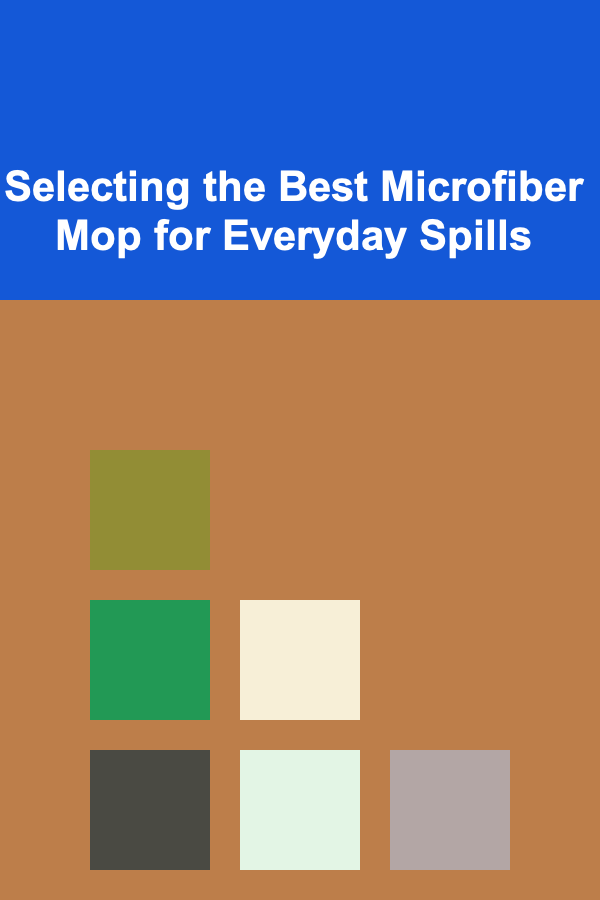
Selecting the Best Microfiber Mop for Everyday Spills
ebook include PDF & Audio bundle (Micro Guide)
$12.99$11.99
Limited Time Offer! Order within the next:

Life is messy. Everyday spills, from dropped coffee to tracked-in mud, are inevitable. While cleaning can feel like a chore, having the right tools can significantly simplify the process. Among the myriad cleaning gadgets available, the microfiber mop stands out as a highly effective and versatile solution for managing everyday spills. However, not all microfiber mops are created equal. Choosing the best one for your needs requires careful consideration of various factors. This in-depth guide will explore these factors, empowering you to select the perfect microfiber mop to conquer those inevitable messes.
Understanding the Allure of Microfiber
Before diving into the specifics of mop selection, it's crucial to understand why microfiber is such a superior cleaning material. Microfiber is a synthetic fiber finer than human hair, typically made from a blend of polyester and polyamide (nylon). This unique composition grants it several key advantages:
- Superior Absorption: The incredibly fine fibers create a vast surface area, allowing microfiber to absorb significantly more liquid and dirt than traditional cotton mops. This means fewer trips to the bucket and a more efficient cleaning process.
- Effective Dirt Trapping: Microfiber acts like a magnet, attracting and trapping dirt, dust, and debris within its fibers. Unlike cotton mops, which tend to push dirt around, microfiber lifts and removes it, leaving surfaces cleaner.
- Scratch-Free Cleaning: The soft, non-abrasive nature of microfiber makes it safe for use on a wide range of surfaces, including hardwood floors, tile, laminate, and vinyl. It cleans effectively without scratching or damaging delicate finishes.
- Hygienic Cleaning: Microfiber's ability to trap dirt and bacteria helps to prevent the spread of germs. Moreover, it can be effectively sanitized in a washing machine, ensuring a clean and hygienic mop head.
- Environmentally Friendly: Microfiber mops often require less water and cleaning solutions than traditional mops, making them a more environmentally friendly choice. They are also reusable and durable, reducing waste compared to disposable options.
- Lightweight and Easy to Maneuver: Microfiber mops are generally lightweight, making them easy to handle and maneuver, even in tight spaces. This reduces strain and fatigue during cleaning.
Types of Microfiber Mops: A Comprehensive Overview
The market offers a variety of microfiber mop types, each with its own strengths and weaknesses. Understanding these different types is essential for making an informed decision.
1. Flat Microfiber Mops
Flat mops are the most common type of microfiber mop, characterized by a flat, rectangular mop head that attaches to a handle. They are generally lightweight, easy to maneuver, and effective for cleaning large areas quickly.
- Pros:
- Versatile: Suitable for various floor types and cleaning tasks.
- Easy to Maneuver: Lightweight and easy to maneuver around furniture and obstacles.
- Large Cleaning Surface: The flat mop head covers a large area, making cleaning faster.
- Machine Washable: Most flat mop heads are machine washable, making them easy to clean and maintain.
- Cons:
- Less Absorbent than String Mops: May require more frequent rinsing for larger spills.
- May Not Reach Tight Corners: The rectangular shape can make it difficult to clean tight corners.
- Ideal For: Hardwood floors, tile, laminate, vinyl, and other smooth surfaces. Good for general cleaning and everyday spills.
2. String Microfiber Mops
String mops, also known as wet mops, feature a mop head made of multiple strands of microfiber. They are known for their excellent absorbency and ability to clean textured surfaces.
- Pros:
- High Absorbency: Excellent for absorbing large spills and cleaning heavily soiled areas.
- Effective on Textured Surfaces: The strands can reach into grooves and crevices, making them ideal for textured floors.
- Durable: String mops tend to be more durable than flat mops, especially those with high-quality construction.
- Cons:
- Heavier than Flat Mops: Can be more tiring to use for extended periods.
- Can be Difficult to Wring Out: Requires a good wringing mechanism to avoid leaving excess water on the floor.
- May Leave Streaks: If not wrung out properly, can leave streaks on smooth surfaces.
- Ideal For: Tile floors, textured surfaces, and areas with frequent spills. Suitable for heavy-duty cleaning.
3. Spray Mops
Spray mops integrate a refillable bottle and spray mechanism into the mop handle. They allow you to apply cleaning solution directly onto the floor, eliminating the need for a separate bucket.
- Pros:
- Convenient: No need for a bucket, making cleaning quicker and easier.
- Precise Application of Cleaning Solution: Allows for controlled application of cleaning solution, minimizing waste.
- Lightweight and Easy to Store: Typically lightweight and compact, making them easy to store.
- Cons:
- Limited Water Capacity: The refillable bottle has a limited capacity, requiring frequent refills for larger areas.
- Can be Expensive: Spray mops tend to be more expensive than traditional mops.
- Potential for Clogging: The spray mechanism can clog if not properly maintained.
- Ideal For: Quick cleanups, small areas, and people with limited mobility. Good for hardwood floors and other surfaces that require minimal water.
4. Spin Mops
Spin mops feature a bucket with a built-in spinning mechanism that wrings out the mop head. They offer a convenient and efficient way to remove excess water from the mop, reducing streaks and speeding up drying time.
- Pros:
- Efficient Wringing: The spinning mechanism effectively removes excess water, preventing streaks and speeding up drying time.
- Hygienic: Keeps hands clean by eliminating the need to manually wring out the mop.
- Reduces Strain: Minimizes strain on hands and wrists.
- Cons:
- Bulky: The bucket can be bulky and difficult to store.
- More Expensive: Spin mops tend to be more expensive than other types of mops.
- Spin Mechanism Can Break: The spinning mechanism is prone to wear and tear and may break over time.
- Ideal For: Large areas, households with pets, and people who want a more hygienic and efficient cleaning experience.
5. Steam Mops
While technically not a "microfiber mop" in the strictest sense, steam mops often utilize microfiber pads to clean and sanitize floors using steam. They are an excellent option for deep cleaning and sanitizing without the use of harsh chemicals.
- Pros:
- Sanitizes: Effectively kills bacteria and germs using steam.
- Chemical-Free Cleaning: Eliminates the need for harsh chemicals.
- Deep Cleaning: Removes stubborn dirt and grime.
- Cons:
- Limited to Certain Floor Types: Not suitable for all floor types, such as unsealed wood floors.
- Requires Electricity: Requires an electrical outlet.
- Can be Expensive: Steam mops are generally more expensive than other types of mops.
- Ideal For: Tile, sealed hardwood floors, and other heat-resistant surfaces. Good for deep cleaning and sanitizing.
Key Factors to Consider When Choosing a Microfiber Mop
Once you understand the different types of microfiber mops available, you need to consider several key factors to determine which one is best suited for your specific needs.
1. Floor Type
The type of flooring you have will significantly influence your mop choice. Different floor types require different cleaning methods and mop head materials.
- Hardwood Floors: Hardwood floors require gentle cleaning to avoid scratching or damaging the finish. Flat microfiber mops and spray mops are generally the best choices for hardwood floors, as they apply minimal water and are gentle on the surface. Avoid using steam mops on unsealed hardwood.
- Tile Floors: Tile floors are more durable and can withstand more rigorous cleaning. String mops, flat mops, and steam mops are all suitable for tile floors. Choose a mop with a scrubbing pad or abrasive fibers for removing stubborn dirt and grime.
- Laminate Floors: Laminate floors are similar to hardwood floors and require gentle cleaning. Flat microfiber mops and spray mops are good choices for laminate floors. Avoid using excessive water, as it can seep into the seams and damage the floor.
- Vinyl Floors: Vinyl floors are durable and easy to clean. Flat mops, string mops, and spray mops are all suitable for vinyl floors. Choose a mop with a non-abrasive pad to avoid scratching the surface.
2. Spill Frequency and Type
Consider how frequently you encounter spills and the types of spills you typically deal with. If you frequently have large spills, a highly absorbent string mop or a spin mop with a good wringing mechanism is a good choice. For smaller, everyday spills, a flat mop or spray mop may suffice.
- Large Spills: String mops and spin mops are ideal for absorbing large volumes of liquid.
- Sticky Spills: Mops with scrubbing pads or abrasive fibers can help remove sticky residue.
- Greasy Spills: Hot water and a degreasing cleaning solution are effective for cleaning greasy spills. Choose a mop that can withstand hot water.
- Everyday Spills: Flat mops and spray mops are convenient for quick cleanups of everyday spills.
3. Cleaning Area Size
The size of the area you need to clean will also influence your mop choice. For large areas, a flat mop with a wide mop head or a spin mop with a large bucket is more efficient. For smaller areas, a spray mop or a smaller flat mop may be sufficient.
- Large Areas: Flat mops with wide mop heads and spin mops are more efficient for cleaning large areas.
- Small Areas: Spray mops and smaller flat mops are suitable for cleaning small areas.
- Tight Spaces: Mops with swivel heads or smaller mop heads are easier to maneuver in tight spaces.
4. Ease of Use and Maneuverability
Consider how easy the mop is to use and maneuver. Look for a lightweight mop with a swivel head that allows you to easily clean around furniture and obstacles. Also, consider the height of the handle and whether it is adjustable to suit your height.
- Weight: Choose a lightweight mop to reduce strain and fatigue during cleaning.
- Swivel Head: A swivel head allows you to easily maneuver the mop around furniture and obstacles.
- Adjustable Handle: An adjustable handle allows you to customize the mop to your height, reducing back pain.
- Wringing Mechanism: Choose a mop with a wringing mechanism that is easy to use and effectively removes excess water.
5. Durability and Maintenance
Choose a mop that is made from durable materials and is easy to maintain. Look for a mop with a sturdy handle and a mop head that is machine washable. Also, consider the availability of replacement mop heads.
- Handle Material: Look for a mop with a sturdy handle made from materials such as aluminum or stainless steel.
- Mop Head Material: Choose a mop head made from high-quality microfiber that is durable and absorbent.
- Machine Washable: Ensure that the mop head is machine washable for easy cleaning and maintenance.
- Replacement Mop Heads: Check the availability and cost of replacement mop heads.
6. Budget
Microfiber mops range in price from relatively inexpensive to quite expensive. Set a budget before you start shopping and stick to it. Consider the long-term cost of ownership, including the cost of replacement mop heads and cleaning solutions.
Top Features to Look for in a Microfiber Mop
Beyond the basic types and considerations, here are some specific features that can significantly enhance the performance and usability of a microfiber mop:
- Dual-Action Microfiber Pads: Some mop heads feature dual-action microfiber pads with different textures for different cleaning tasks. One side may be designed for general cleaning, while the other side may be designed for scrubbing or removing stubborn stains.
- Extendable Handle: An extendable handle allows you to adjust the mop to your height, reducing back strain.
- Refillable Solution Tank (for Spray Mops): A refillable solution tank allows you to use your own preferred cleaning solutions. Look for a tank that is easy to fill and clean.
- Bucket with Separate Clean and Dirty Water Compartments (for Spin Mops): Some spin mops feature buckets with separate compartments for clean and dirty water, preventing you from mopping with dirty water.
- Foot Pedal Wringing Mechanism (for Spin Mops): A foot pedal wringing mechanism allows you to wring out the mop without bending over.
- Adjustable Steam Settings (for Steam Mops): Adjustable steam settings allow you to customize the steam output for different floor types and cleaning tasks.
- Washable and Reusable Pads: Ensure the mop pads are machine washable and reusable to minimize waste and save money.
- Easy Pad Attachment/Detachment: Look for a mop with a user-friendly mechanism for attaching and detaching the mop pad, making it easy to switch pads or remove them for washing. Velcro closures or clip systems are common.
- Low Profile Design: A low profile mop head can easily reach under furniture and into tight spaces.
Tips for Effective Microfiber Mop Cleaning
Even the best microfiber mop will only be as effective as the cleaning techniques you employ. Here are some tips for maximizing the cleaning power of your microfiber mop:
- Pre-Sweep or Vacuum: Always sweep or vacuum the floor before mopping to remove loose dirt and debris. This will prevent the mop from simply pushing dirt around.
- Use the Right Cleaning Solution: Choose a cleaning solution that is specifically designed for your floor type. Avoid using harsh chemicals that can damage the finish.
- Damp Mop, Don't Soak: Avoid soaking the mop head with too much water. The mop should be damp, not dripping wet. Excess water can damage certain floor types and leave streaks.
- Overlap Your Strokes: Overlap your strokes slightly to ensure that you cover the entire floor surface.
- Rinse the Mop Head Frequently: Rinse the mop head frequently in clean water to remove dirt and debris. If you're using a spin mop, use the spinning mechanism to remove excess water and dirt.
- Wash the Mop Head Regularly: Wash the mop head in the washing machine after each use to remove dirt, bacteria, and cleaning solution residue. Use a mild detergent and avoid using fabric softener, as it can reduce the absorbency of the microfiber. Air dry the mop head or tumble dry on low heat.
- Replace Mop Heads Regularly: Replace the mop head every few months, or more frequently if it becomes worn or damaged.
- Spot Clean Spills Immediately: Address spills as soon as they occur to prevent them from setting in and becoming more difficult to remove.
Conclusion
Selecting the best microfiber mop for everyday spills is an investment in a cleaner, healthier home. By understanding the different types of mops available, considering your floor type, spill frequency, and cleaning area size, and paying attention to key features like ease of use, durability, and budget, you can choose the perfect mop to conquer those inevitable messes. Remember to follow proper cleaning techniques to maximize the effectiveness of your microfiber mop and keep your floors looking their best. With the right microfiber mop in hand, you can tackle everyday spills with confidence and enjoy a cleaner, more comfortable living space.

How to Create Effective Ad Campaigns for Small Businesses
Read More
How to Keep Your Home Free from Termites and Pests
Read More
How to Keep Your Pet's Teeth Healthy at Home
Read More
How to Manage Noise from Neighbors in a Shared Building
Read More
How to Train Your Cat to Use a Litter Box Properly
Read More
Why You Should Use Clear Containers for Storage
Read MoreOther Products

How to Create Effective Ad Campaigns for Small Businesses
Read More
How to Keep Your Home Free from Termites and Pests
Read More
How to Keep Your Pet's Teeth Healthy at Home
Read More
How to Manage Noise from Neighbors in a Shared Building
Read More
How to Train Your Cat to Use a Litter Box Properly
Read More